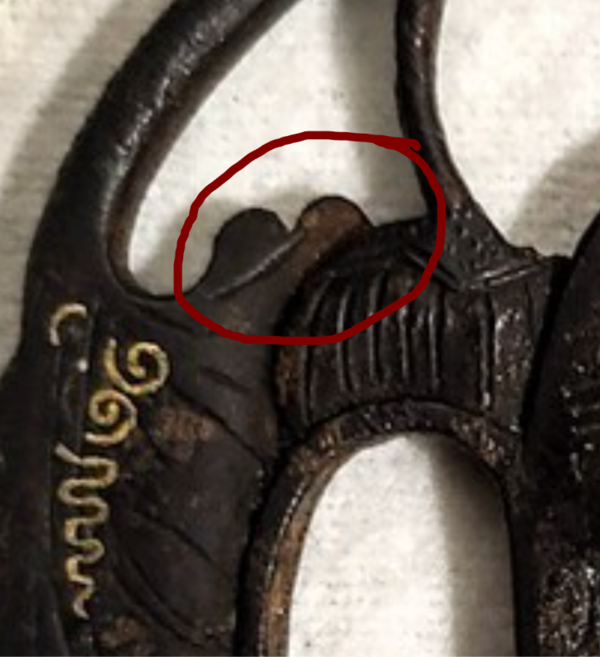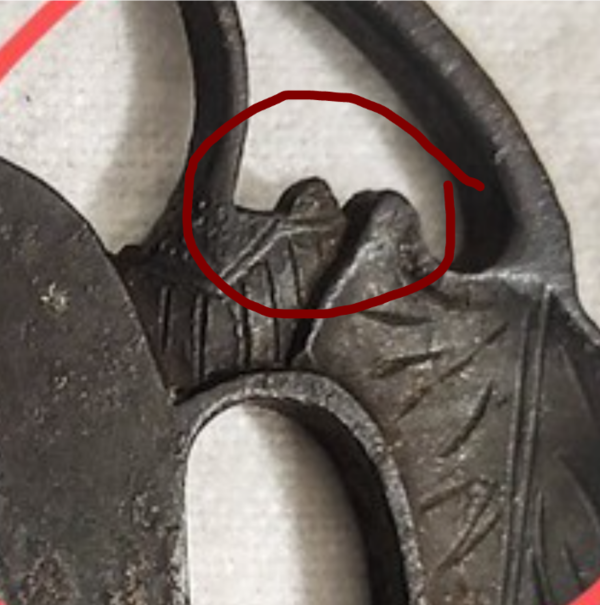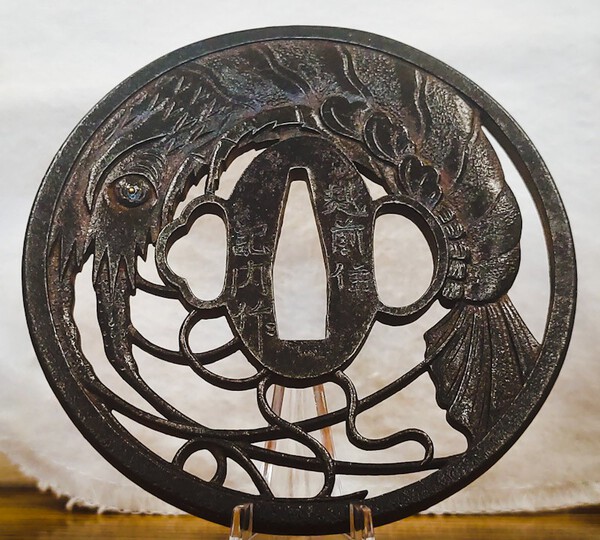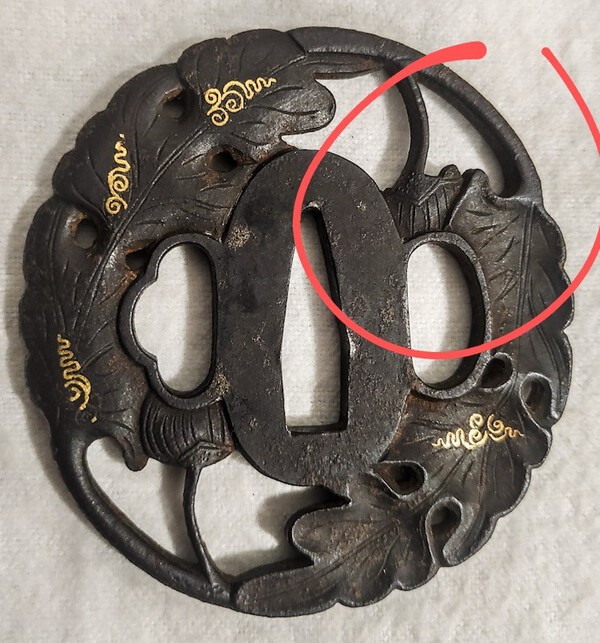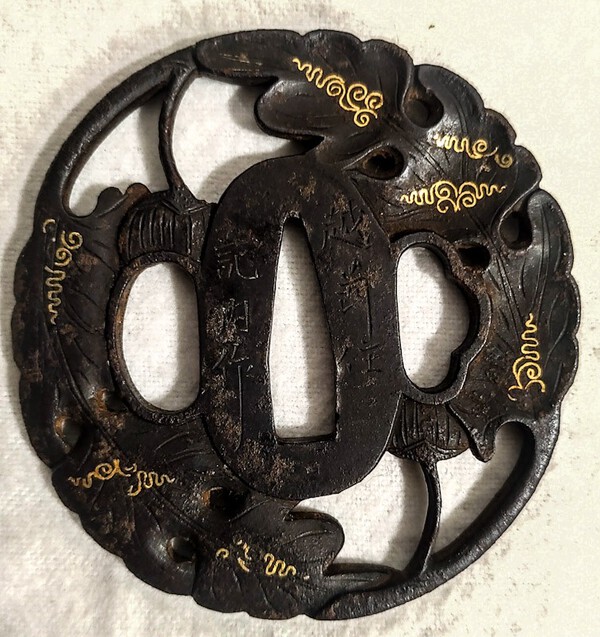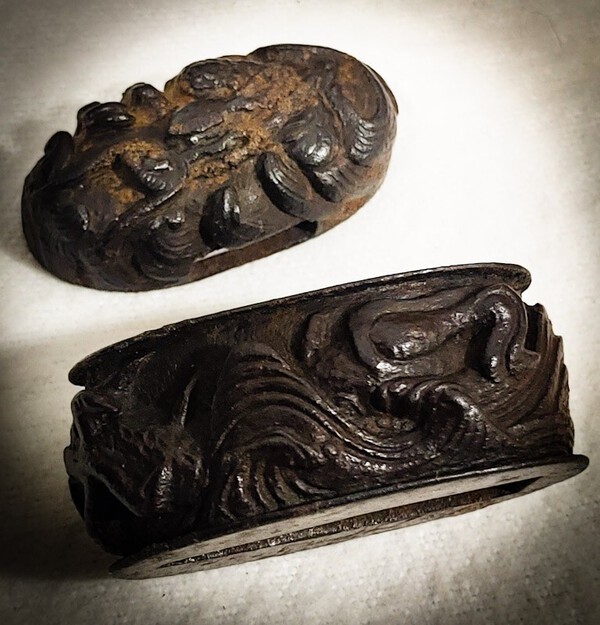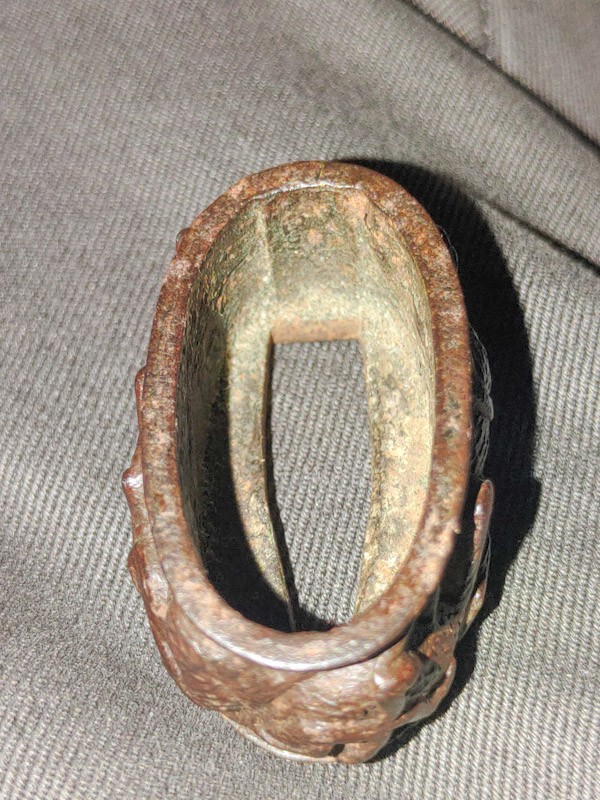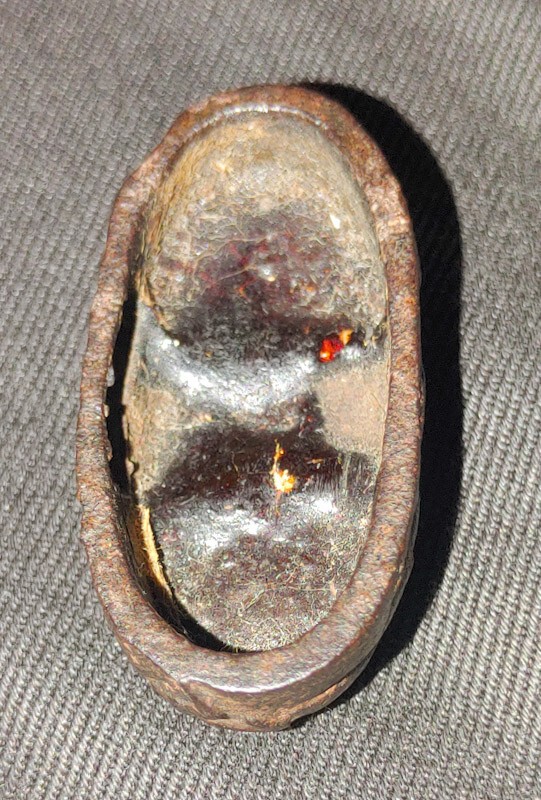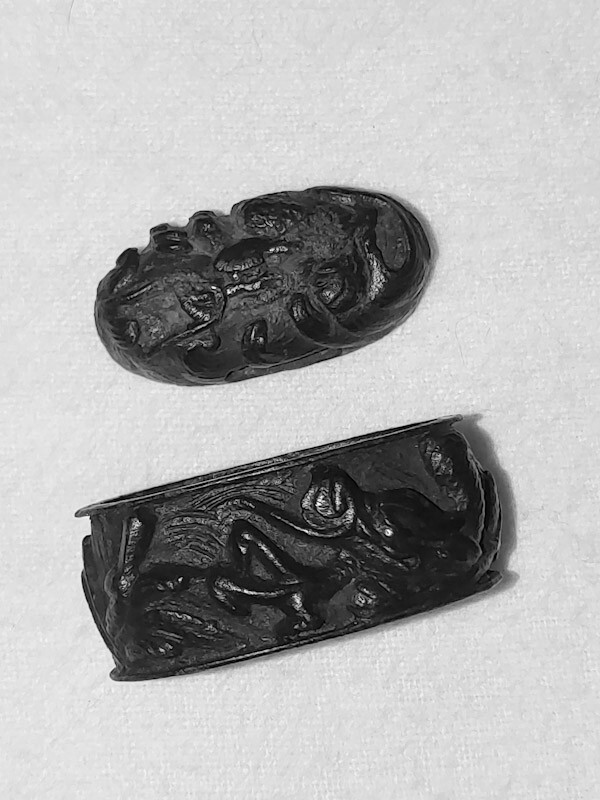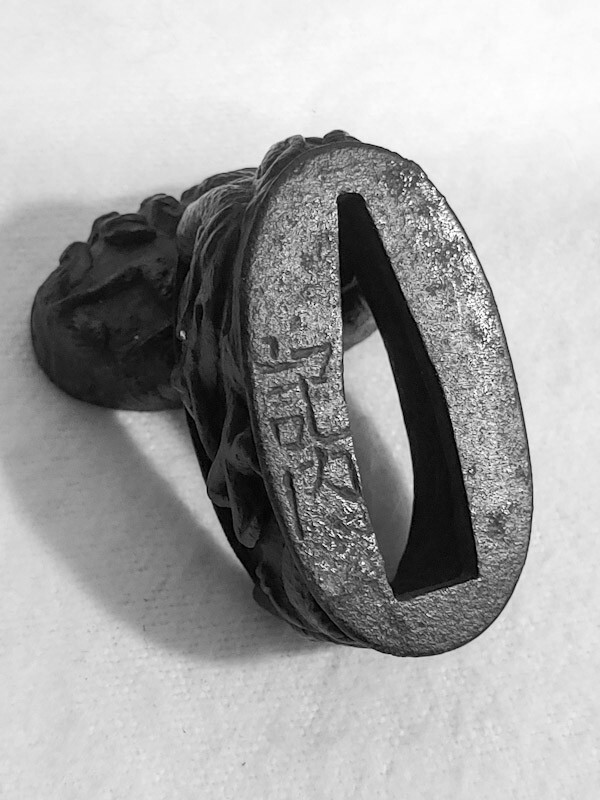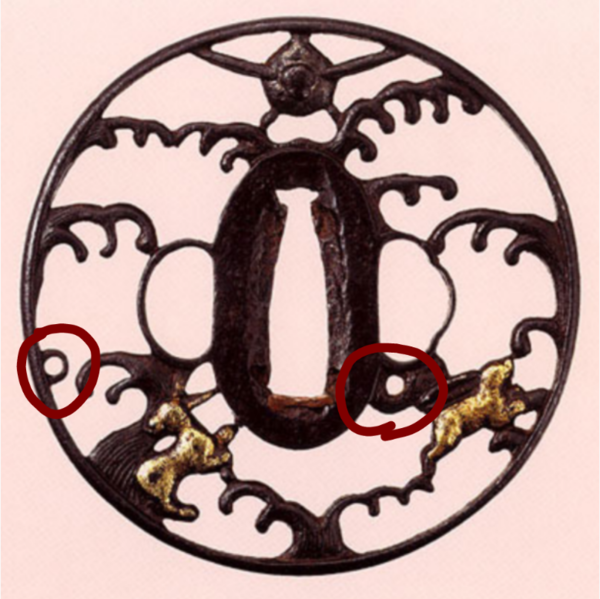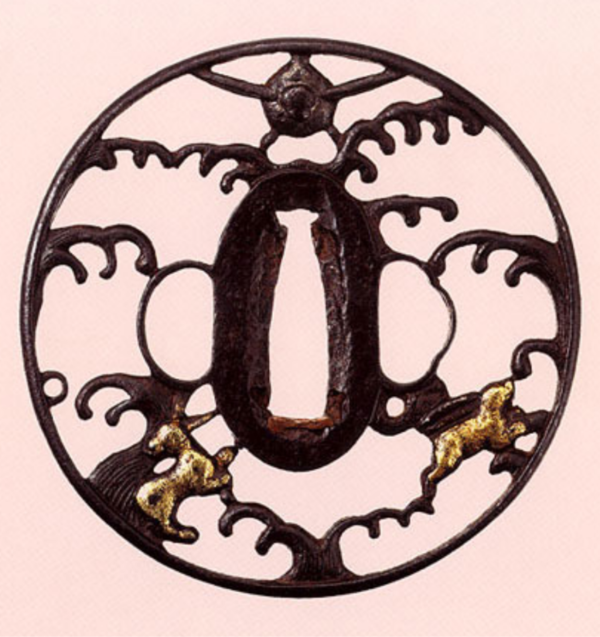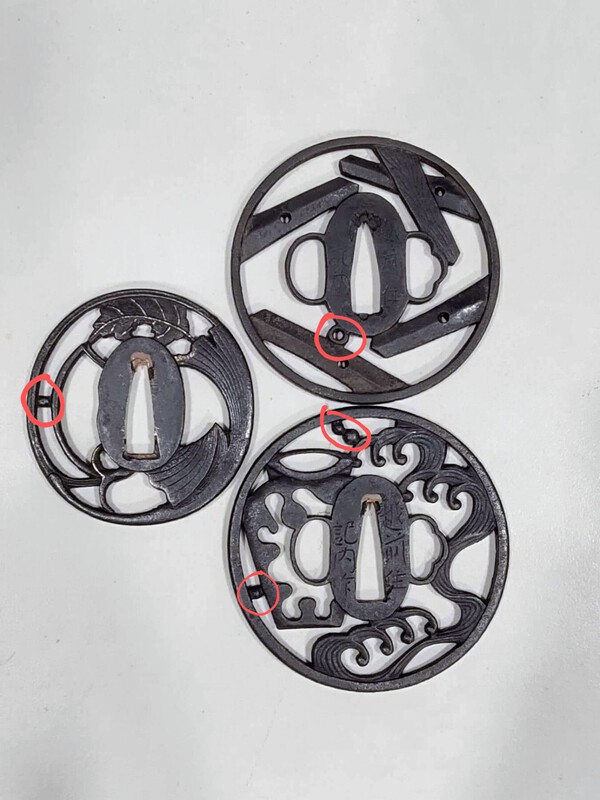-
Posts
153 -
Joined
-
Last visited
Content Type
Profiles
Forums
Events
Store
Downloads
Gallery
Everything posted by Deez77
-
Hi friends, Additional pictures of one of the examples I posted in this thread previously. Seems pretty minimalist, but the shachi head appears so well done to me. Not a typical Kinai style (based on all the reference material I've seen), assuming signature is authentic. Damon
-
Very cool input and leads from everyone. Thank you all. After checking those and the other responses, comb(s), cross section of melon, representation of solar eclipse seen in Japan in 1500's, gear, and Jesuit symbol are all mentioned...as is "crossover" piece, although I'm not entirely sure what that means tbh. The Jesuit symbol was apparently a 32-point one, which some of the examples linked above had. I just counted mine and interestingly enough, 4/5 sections have 19 "spokes" while the one at the 7-8 o'clock position has 18. Strange! 🤔 I wonder what the significance of that is. Damon
-
Hi all, Does anyone have a clue about the motif of this Kinai tsuba I have? I assumed gear of some sort, but that was just a guess. I've seen some described as sun rays, but those have a clearly less symmetrical design than mine. Many thanks for any inputor insights. Damon
-

Echizen Kinai tsuba box translation request
Deez77 replied to Deez77's topic in Translation Assistance
Thanks a lot Steve and K. Morita. Pretty cool to know that someone so prominent judged the tsuba as one of the best (presumably of the school). Perhaps I should send to shinsa to see if it will attain Tokubetsu Hozon. Damon S. -

Echizen Kinai tsuba box translation request
Deez77 replied to Deez77's topic in Translation Assistance
Awesome! Thank you Mauro. -

Echizen Kinai tsuba box translation request
Deez77 replied to Deez77's topic in Translation Assistance
Thank you so much Piers. I really appreciate you taking the time to reply. You mentioned "Kanzan" in your response. Excuse my ignorance, but is that the name of the person who wrote this out and signed with hanko? If so, is there a full name for my own reference? Many thanks. Damon -
Hello all, I've got a beautiful four chrysanthemum Kinai tsuba papered NBTHK Hozon with quite a bit of writing on the box (outside and inside). Would someone be able to provide a translation and possibly any thoughts on the significance? Thank you in advance, and happy holidays to all. Damon
-
Sincere thanks to you all for giving me some specific terms to search for when looking for similarly style tsuba. Given that at least two of the three samples I shared are from the Echizen Kinai school, do you think the inlays were added later, and perhaps in a different region? Or could that be original to the work? Damon
-
Hello all, Could one of the experts here tell me what this type of brass inlay is called and any additional information (which schools used it, how common, any purpose other than decorative, any meaning to the styling, etc)? Three examples below include: 1) from own collection, 2) from Tsuruoka, and 3) currently available on https://nihontou.jp/choice03/tousougu/tuba/560/00.htm. Thank you Damon
-
Hi all. Here's an example currently available on choshuya. http://ginza.choshuya.co.jp/sale/gj/2017/11/08_tb.htm
-
Could it be Kashu Ietsugu?
-
-
Thank you, yes, I agree... it's definitely not the appropriate way to describe these unique features. I'll refrain from using that term. However, I've seen many examples of this design before, but not these extra little parts like an extra part of the leaf and the disfiguration or bump on the acorn's shell.
-
While not related to the original post, I'm sharing a beautiful piece from my collection for reference which shows a similar lobster motif Kinai tsuba mentioned in the excerpt shared by spartancrest.
-
Another piece from my collection with a different type, but similarly odd 'error' on it. Strange that the 'acorn' has this shape, and why would there be double parts of the leaf on the other side? I wonder if others find these strange bits on their tsuba.
-
Yes. I can definitely agree with your observation that they don't look typical. They both appear to be single pieces of metal, and they are both a bit corroded and 'gunky', and the kashira has some kind of dried 'goop' on the inside. I've added a couple of new pictures from various angles and the undersides. Thanks again for your input. Damon
-
Hello all, Hoping for input from those much more knowledgeable on the subject. Some years ago, I picked up the below set of dragon themed fuchi / kashira and the fuchi is signed 'Kinai'. I definitely would have bought them online, but don't recall from where. I liked the set as an oddity, as I'm not aware of the Echizen school making these, so thought it might be quite unique. Is anyone here aware of other examples of fuchi / kashira being made by the Kinai school? What are your thoughts of mine? Authentic? Gimei? Would appreciate your thoughts.
-
Yes. Well said. I guess that's just it. Those parts were put there intentionally. They're most likely got to symbolize something... it's just not clear what that is. Thanks again.
-
Hi Jean, Thank you very much for your comment. Others have mentioned the use of those elements as stimulated waters drops (or dew) as well, and I can see how that would work in certain motifs with the small ball-shaped ones, but the two in this recent example look nothing like water (to me at least) which is why I find them unusual. I mean, nearly the whole tsuba had obvious water elements, so those two circular bits just don't seem to "fit in" if you know what I mean.
-
Hello again all, I came across another strange (to me) use of those "joiners" on a tsuba on Japansword.co.jp. For something so well planned and thought out, it's still puzzling (to me) why a craftsman would include these.
-
Wow. Some great points from everyone. I can totally see how the joiners look like drops of water in some cases, and will need to look into udenuki-no-ana a bit more, so thanks for the resource. Yes JohnTo, for something so we'll planned out, these joiners don't make much sense to me either. Why not just make a completely cohesive design that doesn't require these little additions. Very interesting observations about the broken pot tsuba. If there are multiple examples of the same design signed by artists from various schools, and an unsigned one goes for shinsa, how do they determine which school to attribute the piece to? Majority rules? Thank you all for your contributions. Very insightful.
-
Thank you all very much for your input. I do find these little things strange, given how exact and deliberate I imagine Japanese craftsmen being, and the fact that most tosogu have some very specific design theme/motif. As you all have said, I would also expect all of these works to have been planned, designed, possibly sketched out well in advance of the actual work beginning. In that case, why these obscure little "joiners" were included in that form, as a visually separate/different thing, and not just part of the overall design, is surprising to me. I guess, potentially, it just made sense to include them for the extra strength/durability aspect in as simple a fashion as possible. These craftsmen were operating a business after all.
-
Greetings all, I'm new to the NMB, and this is my first created thread (although I've been reading through the archive). I'm hoping for your valuable input regarding three tsuba I have in my collection which display what I can only assume are some type of error in their creation. Intriguing to me, really. It's as if the Craftsman only realized at some point during the construction that the line he took wasn't quite right, and the tsuba's strength/structural integrity would be compromised (when struck?) if a small "spacer" wasn't created for reinforcement. You can see them circled in the image. Certainly, it's not an embellishment of the design/motif, as it distracts from the design (in my opinion), so what are they really? And is there a proper name for them? Thanking you in advance for your guidance. Damon
-
Dear all, I just wanted to thank Bruno for offering some of his pieces to the community here, and to leave a very positive review of my dealing with him. Bruno is a great communicator and a generous individual. Our transaction was extremely smooth, the item was shipped promptly and was packaged very securely, and Bruno included a couple of very thoughtful 'extras' which were completely unexpected, but very much appreciated. Thank you again, Bruno. Regards
-
Hello, I'm Damon. Born in Texas, but grew up in Louisiana. I've been living as an expat for the last 22 years, and was fortunate enough to have lived in Japan for over four years during that time. Amazing place, and just reinforced my interest and love for the place. I've had an interest in Japan from a young age, probably in large part due to an officer's sword my grandmother had in her house that I would get glimpses of when visiting during summer breaks. Other interests include history, militaria, antiques, and collecting (in general). My current collection of Japanese wares includes inro, other laquer, and a modest tsuba collection. I also have a number of books on the subject. I'm certainly interested in learning from all of you, and contributing where I can. Many thanks to those who set up this site and those who contribute. There's a lot to go through.

















